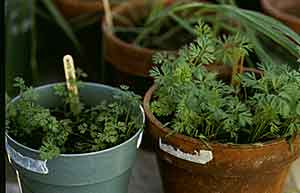Many domesticated plant species are polyploids of their wild relatives, but this is not the case for carrot (2n=18 for both the wild and domestic types). The domestic types - if you let them grow a second year and go to seed - will cross freely with wild carrot which is a very common weed in Nova Scotia, especially in hay fields and on the roadside.
As is true of many other domesticated plant species, the domestic type is a larger version of the wild one; both foliage and roots of domestic carrot are larger than those of the wild types. The roots of domestic carrot lack the secondary plant compounds that the wild carrot contains (and that can make you ill if you east them).
Unlike grains, there has been no selection for large seed size in domestic carrots as it is the root, not the seeds that is harvested. Consequently, seeds of the domestic carrot are the same size as those of the wild carrot. However they do lack the appendages seen on seeds of the wild carrot. Those function in distributing the seed of the wild species by attaching the seed to animals.
Also the seeds of the domestic species do not persist as dormant seed in the seedbank as the do seeds of wild carrot. Seeds of the domestic species exhibit 100% germination after seeeding, while only about 10% of less of the seeds of wild carrots similarly sown will germinate immediately.

Wild carrot (left) and domestic carrot (right) sown at the same time in the same potting medium. The leaves have the same shape but those of the domestic type are about twice the size of the wild type.
Below, the flower of Wild Carrot, commonly known as Queen Anne's Lace. In the very centre of the influorescence is a single purple flower.

At right: Seeds of wild carrot bear appendages, those of domestic carrot do not.
The bar is 6 mm in length

Contributed by D. Patriquin
Photos by David Patriquin (Dalhousie University)